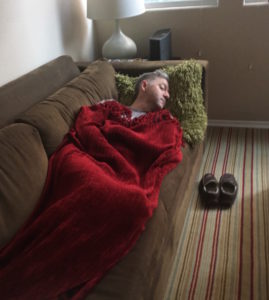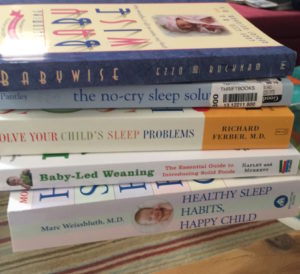 Getting the Baby to Sleep
Getting the Baby to Sleep
This time last year I was in San Diego, taking care of my youngest granddaughter while her mother finished her Internal Medicine residency and her father worked upstairs in his office.
Since I have returned home, I have been thinking a lot about sleep.
It’s well known that new parents get very little sleep. Other people living in the household may also discover that their sleep is interrupted. I certainly did, on the one hand because I offered to take some of the night feedings from the very beginning, and on the other hand because my room was closest to the nursery.
Getting babies to sleep through the night is not a new challenge. My parents had an anecdote that they often repeated during my parenting years, about the night my father climbed the steep stairs to the second story where I had been wailing for some time. I was so happy to see him, I laughed out loud. I’ll spare you the end of the story. (Daddy wasn’t happy with my response.)
When I was caring for my own babies, I took the easy way out: I breastfed them, and they slept in bed with me. In my memory, that avoided sleep problems. In reality, I discovered, when I recently re-read my journals of that period, it simply meant that when they awakened, neither of us needed to go down the hall to fetch them. S/he was right beside us. There was plenty of wakefulness going on in our household, I discovered, and we new parents were quite grumpy about it much of the time.
The parents of today, Gen-Xers and Millennials, have a way of re-branding certain elements in their lives that have existed in previous eras, and addressing them with re-framed playbooks. I suppose they do that to distance themselves from those of us who are commonly believed to have screwed up everything we touched. In writing for these pages I have come across baby welcoming ceremony (a variation on “baby shower”), family birth center (“rooming in”), physiological birth (“natural childbirth”), attachment parenting (“common sense parenting”), baby-led weaning (“introducing solid foods”), and, related to this topic, sleep training (“letting the baby cry it out”).
Six weeks into the life of my gorgeous little granddaughter, my son and daughter-in-law were feeling the effects of new parenthood, and were searching for the pathway to a good night’s sleep.
Teaching the Baby to Sleep
After reading everything they could get their hands on, and talking to friends and siblings, they decided the solution was Sleep Training.
As a grandmother who had never managed to teach her children how to sleep on schedule (I never taught them how to tie their shoes, either, but that’s a story for another day), I had to be taught by my children how to watch for cues that my new grandchild was ready to go to sleep. I was also introduced to the concept of getting Adelaide used to eating on a regular schedule in order to help her sleep on one.
The idea was that we needed to teach our little girl how to fall asleep on her own. Nursing a baby to sleep, which was how I did it, doesn’t accomplish that goal. In any case, I was feeding Adelaide her mother’s milk from a bottle, and she could empty those bottles in record time and still be wide awake when she was done. Or, if I mistimed her feeding, she would nod off half-way through the bottle then wake up hungry a half hour later. I was instructed to watch for eye-rubbing or yawning, then to put her in her bed before she was actually asleep.
That all made sense to me, but I had a big hurdle to overcome. I can’t stand to hear a baby cry. All the books on sleep training say, in one way or another, “It’s ok for them to cry a little at first. Just make sure they are well fed, dry and warm, and lying on their backs.” “A little” is rarely defined, and when it is, it’s way too long for my tolerance.
This wisdom — that it’s ok for a baby to cry before falling asleep — is common in sleep training books and blogs, and here is the justification, from Judith-Rose Max of Happy Parenting:
Feeding the Baby on Schedule
In order to help me overcome my “old fashioned” attitude toward crying, I was given a schedule, similar to this one from on the online Baby Sleep Site®:
Sample 3 Month Old Sleep and Feeding Schedule
Breastfed 3 Month Old Baby
7:00 — Wake (*Fixed Point)
8:00 — Feed
8:30 — Nap (*Fixed Point)
9:00 — Wake and Feed
11:00 — Feed and Nap
1:00 — Wake and Feed
2:00 — Nap
2:30 — Wake and Feed
4:30 — Feed and Nap
6:30 — Feed
7:00 — Catnap
9:00 — Feed and Bedtime (*Fixed Point)
10:30 — Fill-Up Feed (Fill-Up Feeds should always take place at Mom’s
bedtime, so mom gets a long stretch of sleep; be sure to use breast
compressions at bedtime and night feedings)
+ 1-3 night feedings
Feeding and sleeping are integral at the beginning of a child’s life, so if one wants the baby to sleep on some kind of a schedule, it’s important that the baby eat on a schedule too.
What’s Old Becomes New
The irony here, of course, is that in my parents’ day it was quite common for parents to let their children cry themselves to sleep. I had been part of the “modern” generation of the 1970s who decided that was cruel and unnecessary, and so I fed my babies on demand, and put them in their beds only after they had already fallen asleep. Now I was told that my parents had it right all along. Just like recycling, which our grandparents did quite naturally, the old becomes new again when a generation that has forgotten its roots rediscovers the pathway on its own.
But I still wasn’t willing to let my granddaughter cry it out.
 Well, this story has a happy ending. We followed the feeding/sleeping schedule as well as we could, given my aversion to crying and John’s unwillingness to give up evening bike rides with his daughter in the trailer behind him. Then, half-way through my six-month residency in San Diego, I went home for a week.
Well, this story has a happy ending. We followed the feeding/sleeping schedule as well as we could, given my aversion to crying and John’s unwillingness to give up evening bike rides with his daughter in the trailer behind him. Then, half-way through my six-month residency in San Diego, I went home for a week.
When I came back, Adelaide was sleeping through the night and going down for naps without so much as a squawk. She awakened happily in the morning and after her naps, pleased to see us. I never asked my son how they accomplished it, and he never offered to tell me. Now he and his two sisters, his advisors on this aspect of parenting, each have a toddler who cheerfully goes down for naps and to bed, most days, without drama.
Once again I am reminded that there are many loving ways to raise a child, and most of them work.
Join me next time when I address the sleep challenges of older people. It turns out they are similar to those of new babies, and — surprise — so are the solutions.
As you can see, I have returned to writing my monthly commentary on families and food, reflections of being a grandmother, and whatever else strikes my fancy. I hope you’ll come along for the journey. If you’d like my posts to come to your email each time I write one, just type your email address into the subscription form on this page and send it to me. If you’d like to start a conversation about sleep training, please do so in the Comment section below.
Share this post





Wow, I could have written that story. I had the same problem with especially my second son who had his days and nights mixed up, he still does. I could not listen to his crying long enough for him to go to sleep, once I went in and picked him up, he slept. Same thing with my new puppy. I wanted her to be cage trained but same thing I didn’t like her crying, so I slept upstairs and Chuck had her with him. She would stop after a few cries but then in a few days I came back into the bedroom and she started again. She now sleeps with us on the bed. Oh well
I love your stories Marlene.
Janet
Thanks so much for your contribution to this conversation, Janet, and for your kind words. Puppies and children do have their similarities, don’t they?
Marlene